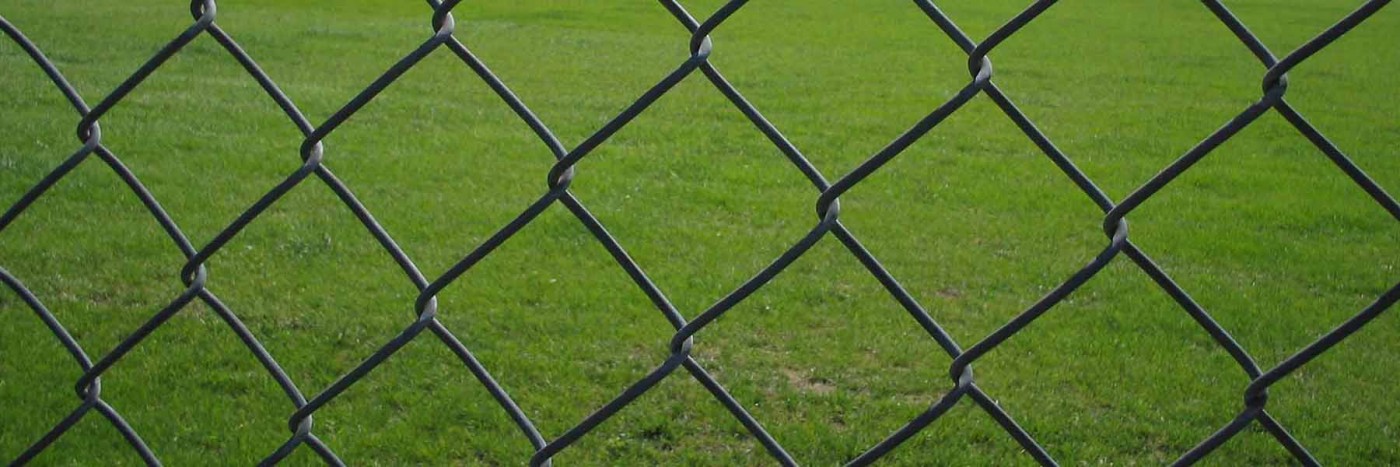Chainlink Fencing #Chainlink #Fencing #Manufacturer #Supplier A chain-link fence (also referred to as wire netting, wire-mesh fence, chain-wire fence, cyclone fence, hurricane fence, or diamond-mesh fence) is a type of woven fence usually made from galvanized coated steel wire. The wires run vertically and are bent into a zig-zag pattern so that each "zig" hooks with the wire immediately on one side and each "zag" with the wire immediately on the other. This forms the characteristic diamond pattern seen in this type of fence. Sizes and uses In the United States, fencing usually comes in 50 ft rolls, which can be joined by "unscrewing" one of the end wires and then "screwing" it back in so that it hooks both pieces. Common heights include 3 ft, 4 ft 5 ft, though almost any height is possible. Common mesh gauges are 8, 10, and 12. Mesh length can also vary based on need, with the standard mesh length being 3". For Farms boundry, the most popular height is 5 ft, and farms use a mesh length of 3". Installation The installation of chain-link fence involves setting posts into the ground and attaching the fence to them. The posts may be steel tubing, timber or concrete and may be driven into the ground or set in concrete. End, corner or gate posts, commonly referred to as "terminal posts", must be set in concrete footing or otherwise anchored to prevent leaning under the tension of a stretched fence. Posts set between the terminal posts are called "line posts" and are set at intervals not to exceed 10 feet. The installer attaches the fence at one end, stretches it, and attaches at the other, easily removing the excess by "unscrewing" a wire. Finally, the installer ties the fence to the line posts with aluminum wire. In many cases, the installer stretches a bottom tension wire, sometimes referred to as "coil wire", between terminal posts to help minimize the in and out movement that occurs at the bottom of the chain-link mesh between posts. Top horizontal rails are used on most chain-link fences, although not necessary. Bottom rails may be added in lieu of bottom tension wires, and for taller fences, 10 feet or more, intermediate horizontal rails are often added. Once stretched, a bottom wire should be secured to the line posts and the chain-link mesh "hog ringed" to the tension wire 2' on center. One generally installs this wire before installing the chain-link mesh. #Chainlink-Manufacturer-in-Vadodara-Bharuch-Halol-Anand-Jambusar #Chainlink-Supplier-in-Vadodara-Bharuch-Halol-Anand-Jambusar #Chainlink-Fencing-Manufacturer-and-Supplier-in-Vadodara-Bharuch-Halol-Anand-Jambusar #Chainlink-Jali-Vadodara Dashrath-Karachiya-Road Vadodara 391310 Gujarat
Chat with us on WhatsApp
×
This is your website preview.
Currently it only shows your basic business info. Start adding relevant business details such as description, images and products or services to gain your customers attention by using Boost 360 android app / iOS App / web portal.
https://www.rajeshgroups.com/latest-update/chainlink-fencing-chainlink-fencing-manufacture/51
Chainlink Fencing #Chainlink #Fencing #Manufacture...

2018-03-01T07:50:38
Chainlink Fencing #Chainlink #Fencing #Manufacturer #Supplier A chain-link fence (also referred to as wire netting, wire-mesh fence, chain-wire fence, cyclone fence, hurricane fence, or diamond-mesh fence) is a type of woven fence usually made from galvanized coated steel wire. The wires run vertically and are bent into a zig-zag pattern so that each "zig" hooks with the wire immediately on one side and each "zag" with the wire immediately on the other. This forms the characteristic diamond pattern seen in this type of fence. Sizes and uses In the United States, fencing usually comes in 50 ft rolls, which can be joined by "unscrewing" one of the end wires and then "screwing" it back in so that it hooks both pieces. Common heights include 3 ft, 4 ft 5 ft, though almost any height is possible. Common mesh gauges are 8, 10, and 12. Mesh length can also vary based on need, with the standard mesh length being 3". For Farms boundry, the most popular height is 5 ft, and farms use a mesh length of 3". Installation The installation of chain-link fence involves setting posts into the ground and attaching the fence to them. The posts may be steel tubing, timber or concrete and may be driven into the ground or set in concrete. End, corner or gate posts, commonly referred to as "terminal posts", must be set in concrete footing or otherwise anchored to prevent leaning under the tension of a stretched fence. Posts set between the terminal posts are called "line posts" and are set at intervals not to exceed 10 feet. The installer attaches the fence at one end, stretches it, and attaches at the other, easily removing the excess by "unscrewing" a wire. Finally, the installer ties the fence to the line posts with aluminum wire. In many cases, the installer stretches a bottom tension wire, sometimes referred to as "coil wire", between terminal posts to help minimize the in and out movement that occurs at the bottom of the chain-link mesh between posts. Top horizontal rails are used on most chain-link fences, although not necessary. Bottom rails may be added in lieu of bottom tension wires, and for taller fences, 10 feet or more, intermediate horizontal rails are often added. Once stretched, a bottom wire should be secured to the line posts and the chain-link mesh "hog ringed" to the tension wire 2' on center. One generally installs this wire before installing the chain-link mesh. #Chainlink-Manufacturer-in-Vadodara-Bharuch-Halol-Anand-Jambusar #Chainlink-Supplier-in-Vadodara-Bharuch-Halol-Anand-Jambusar #Chainlink-Fencing-Manufacturer-and-Supplier-in-Vadodara-Bharuch-Halol-Anand-Jambusar #Chainlink-Jali-Vadodara Dashrath-Karachiya-Road Vadodara 391310 Gujarat
2018-03-01T07:50:38
Keywords
- line posts
- bottom wire
- wire netting
- cyclone fence
- terminal posts
- tension wire 2
- hurricane fence
- coated steel wire
- installer attaches
- Common mesh gauges
- installer stretches
- standard mesh length
- bottom tension wires
- Chainlink-Jali-Vadodara
- intermediate horizontal rails
- characteristic diamond pattern
- Chainlink-Supplier-in-Vadodara-Bharuch-Halol-Anand-Jambusar
- Chainlink-Manufacturer-in-Vadodara-Bharuch-Halol-Anand-Jambusar
- Chainlink-Fencing-Manufacturer-and-Supplier-in-Vadodara-Bharuch-Halol-Anand-Jambusar

Submit Your Enquiry